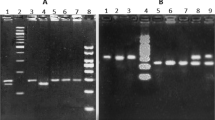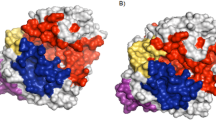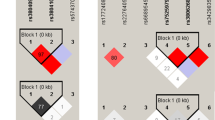Abstract
The MR1 antigen-presenting system is conserved among mammals and enables T cells to recognize small molecules produced by bacterial pathogens, including Mycobacterium tuberculosis (M.tb). However, it is not known whether MR1-mediated antigen presentation is important for protective immunity against mycobacterial disease. We hypothesized that genetic control of MR1 expression correlates with clinical outcomes of tuberculosis infection. We performed an MR1 candidate gene association study and identified an intronic single-nucleotide polymorphism (rs1052632) that was significantly associated with susceptibility to tuberculosis in a discovery and validation cohort of Vietnamese adults with tuberculosis. Stratification by site of disease revealed that rs1052632 genotype GG was strongly associated with the development of meningeal tuberculosis (odds ratio=2.99; 95% confidence interval (CI) 1.64–5.43; P=0.00006). Among patients with meningeal disease, absence of the G allele was associated with an increased risk of death (hazard ratio=3.86; 95% CI 1.49–9.98; P=0.005). Variant annotation tools using public databases indicate that rs1052632 is strongly associated with MR1 gene expression in lymphoblastoid cells (P=0.004) and is located within a transcriptional enhancer in epithelial keratinocytes. These data support a role for MR1 in the pathogenesis of human tuberculosis by revealing that rs1052632 is associated with MR1 gene expression and susceptibility to tuberculosis in Vietnam.
This is a preview of subscription content, access via your institution
Access options
Subscribe to this journal
Receive 6 digital issues and online access to articles
$119.00 per year
only $19.83 per issue
Buy this article
- Purchase on Springer Link
- Instant access to full article PDF
Prices may be subject to local taxes which are calculated during checkout



Similar content being viewed by others
References
WHO. Global Tuberculosis Report 2013. 2013.
Zumla A, Raviglione M, Hafner R, von Reyn CF . Tuberculosis. N Engl J Med 2013; 368: 745–755.
Mogues T, Goodrich ME, Ryan L, LaCourse R, North RJ . The relative importance of T cell subsets in immunity and immunopathology of airborne Mycobacterium tuberculosis infection in mice. J Exp Med 2001; 193: 271–280.
Behar SM, Dascher CC, Grusby MJ, Wang CR, Brenner MB . Susceptibility of mice deficient in CD1D or TAP1 to infection with Mycobacterium tuberculosis. J Exp Med 1999; 189: 1973–1980.
Lin PL, Rutledge T, Green AM, Bigbee M, Fuhrman C, Klein E et al. CD4 T cell depletion exacerbates acute Mycobacterium tuberculosis while reactivation of latent infection is dependent on severity of tissue depletion in cynomolgus macaques. AIDS Res Hum Retroviruses 2012; 28: 1693–1702.
Jasenosky LD, Scriba TJ, Hanekom WA, Goldfeld AE . T cells and adaptive immunity to Mycobacterium tuberculosis in humans. Immunol Rev 2015; 264: 74–87.
Beckman EM, Porcelli SA, Morita CT, Behar SM, Furlong ST, Brenner MB . Recognition of a lipid antigen by CD1-restricted alpha beta+ T cells. Nature 1994; 372: 691–694.
Tanaka Y, Sano S, Nieves E, De Libero G, Rosa D, Modlin RL et al. Nonpeptide ligands for human gamma delta T cells. Proc Natl Acad Sci USA 1994; 91: 8175–8179.
Gold MC, Cerri S, Smyk-Pearson S, Cansler ME, Vogt TM, Delepine J et al. Human mucosal associated invariant T cells detect bacterially infected cells. PLoS Biol 2010; 8: e1000407.
Sandstrom A, Peigne CM, Leger A, Crooks JE, Konczak F, Gesnel MC et al. The intracellular B30.2 domain of butyrophilin 3A1 binds phosphoantigens to mediate activation of human Vgamma9Vdelta2 T cells. Immunity 2014; 40: 490–500.
Vavassori S, Kumar A, Wan GS, Ramanjaneyulu GS, Cavallari M, El Daker S et al. Butyrophilin 3A1 binds phosphorylated antigens and stimulates human gammadelta T cells. Nat Immunol 2013; 14: 908–916.
Kjer-Nielsen L, Patel O, Corbett AJ, Le Nours J, Meehan B, Liu L et al. MR1 presents microbial vitamin B metabolites to MAIT cells. Nature 2012; 491: 717–723.
Treiner E, Duban L, Bahram S, Radosavljevic M, Wanner V, Tilloy F et al. Selection of evolutionarily conserved mucosal-associated invariant T cells by MR1. Nature 2003; 422: 164–169.
Porcelli S, Yockey CE, Brenner MB, Balk SP . Analysis of T cell antigen receptor (TCR) expression by human peripheral blood CD4-8- alpha/beta T cells demonstrates preferential use of several V beta genes and an invariant TCR alpha chain. J Exp Med 1993; 178: 1–16.
Meierovics A, Yankelevich WJ, Cowley SC . MAIT cells are critical for optimal mucosal immune responses during in vivo pulmonary bacterial infection. Proc Natl Acad Sci USA 2013; 110: E3119–E3128.
Georgel P, Radosavljevic M, Macquin C, Bahram S . The non-conventional MHC class I MR1 molecule controls infection by Klebsiella pneumoniae in mice. Mol immunol 2011; 48: 769–775.
Chua WJ, Truscott SM, Eickhoff CS, Blazevic A, Hoft DF, Hansen TH . Polyclonal mucosa-associated invariant T cells have unique innate functions in bacterial infection. Infect Immun 2012; 80: 3256–3267.
Sakala IG, Kjer-Nielsen L, Eickhoff CS, Wang X, Blazevic A, Liu L et al. Functional heterogeneity and antimycobacterial effects of mouse mucosal-associated invariant T cells specific for riboflavin metabolites. J Immunol 2015; 195: 587–601.
Le Bourhis L, Martin E, Peguillet I, Guihot A, Froux N, Core M et al. Antimicrobial activity of mucosal-associated invariant T cells. Nat Immunol 2010; 11: 701–708.
Tsukamoto K, Deakin JE, Graves JA, Hashimoto K . Exceptionally high conservation of the MHC class I-related gene, MR1, among mammals. Immunogenetics 2013; 65: 115–124.
Seshadri C, Thuong NT, Yen NT, Bang ND, Chau TT, Thwaites GE et al. A polymorphism in human CD1A is associated with susceptibility to tuberculosis. Genes Immun 2014; 15: 195–198.
Seshadri C, Shenoy M, Wells RD, Hensley-McBain T, Andersen-Nissen E, McElrath MJ et al. Human CD1a deficiency is common and genetically regulated. J Immunol 2013; 191: 1586–1593.
Ward LD, Kellis M . HaploReg: a resource for exploring chromatin states, conservation, and regulatory motif alterations within sets of genetically linked variants. Nucleic Acids Res 2012; 40 (Database issue): D930–D934.
Boyle AP, Hong EL, Hariharan M, Cheng Y, Schaub MA, Kasowski M et al. Annotation of functional variation in personal genomes using RegulomeDB. Genome Res 2012; 22: 1790–1797.
ENCODE Project Consortium. The ENCODE (ENCyclopedia Of DNA Elements) Project. Science 2004; 306: 636–640.
Roadmap Epigenomics Consortium, Kundaje A, Meuleman W, Ernst J, Bilenky M, Yen A et al. Integrative analysis of 111 reference human epigenomes. Nature 2015; 518: 317–330.
Stranger BE, Nica AC, Forrest MS, Dimas A, Bird CP, Beazley C et al. Population genomics of human gene expression. Nat Genet 2007; 39: 1217–1224.
Hu G, Schones DE, Cui K, Ybarra R, Northrup D, Tang Q et al. Regulation of nucleosome landscape and transcription factor targeting at tissue-specific enhancers by BRG1. Genome Res 2011; 21: 1650–1658.
Cambier CJ, Takaki KK, Larson RP, Hernandez RE, Tobin DM, Urdahl KB et al. Mycobacteria manipulate macrophage recruitment through coordinated use of membrane lipids. Nature 2014; 505: 218–222.
de la Barrera S, Aleman M, Musella R, Schierloh P, Pasquinelli V, Garcia V et al. IL-10 down-regulates costimulatory molecules on Mycobacterium tuberculosis-pulsed macrophages and impairs the lytic activity of CD4 and CD8 CTL in tuberculosis patients. Clin Exp Immunol 2004; 138: 128–138.
Pitt JM, Stavropoulos E, Redford PS, Beebe AM, Bancroft GJ, Young DB et al. Blockade of IL-10 signaling during bacillus Calmette-Guerin vaccination enhances and sustains Th1, Th17, and innate lymphoid IFN-gamma and IL-17 responses and increases protection to Mycobacterium tuberculosis infection. J Immunol 2012; 189: 4079–4087.
Illes Z, Shimamura M, Newcombe J, Oka N, Yamamura T . Accumulation of Valpha7.2-Jalpha33 invariant T cells in human autoimmune inflammatory lesions in the nervous system. Inte Immunol 2004; 16: 223–230.
Willing A, Leach OA, Ufer F, Attfield KE, Steinbach K, Kursawe N et al. CD8(+) MAIT cells infiltrate into the CNS and alterations in their blood frequencies correlate with IL-18 serum levels in multiple sclerosis. Eur J Immunol 2014; 44: 3119–3128.
Croxford JL, Miyake S, Huang YY, Shimamura M, Yamamura T . Invariant V(alpha)19i T cells regulate autoimmune inflammation. Nat Immunol 2006; 7: 987–994.
McWilliam HE, Eckle SB, Theodossis A, Liu L, Chen Z, Wubben JM et al. The intracellular pathway for the presentation of vitamin B-related antigens by the antigen-presenting molecule MR1. Nat Immunol 2016; 17: 531–537.
Harriff MJ, Karamooz E, Burr A, Grant WF, Canfield ET, Sorensen ML et al. Endosomal MR1 trafficking plays a key role in presentation of Mycobacterium tuberculosis Ligands to MAIT cells. PLoS Pathog 2016; 12: e1005524.
Ussher JE, Bilton M, Attwod E, Shadwell J, Richardson R, de Lara C et al. CD161++ CD8+ T cells, including the MAIT cell subset, are specifically activated by IL-12+IL-18 in a TCR-independent manner. Eur J Immunol 2014; 44: 195–203.
Harriff MJ, Cansler ME, Toren KG, Canfield ET, Kwak S, Gold MC et al. Human lung epithelial cells contain Mycobacterium tuberculosis in a late endosomal vacuole and are efficiently recognized by CD8(+) T cells. PLoS One 2014; 9: e97515.
Horne DJ, Randhawa AK, Chau TT, Bang ND, Yen NT, Farrar JJ et al. Common polymorphisms in the PKP3-SIGIRR-TMEM16J gene region are associated with susceptibility to tuberculosis. J Infect Dis 2012; 205: 586–594.
Khor CC, Chau TN, Pang J, Davila S, Long HT, Ong RT et al. Genome-wide association study identifies susceptibility loci for dengue shock syndrome at MICB and PLCE1. Nat Genet 2011; 43: 1139–1141.
Shephard N . GENASS: Stata Module to Perform Genetic Case-control Association tests. Boston College Department of Economics, Boston College: Chestnut Hill, MA, USA, 2005.
Stranger BE, Montgomery SB, Dimas AS, Parts L, Stegle O, Ingle CE et al. Patterns of cis regulatory variation in diverse human populations. PLoS Genet 2012; 8: e1002639.
Ernst J, Kheradpour P, Mikkelsen TS, Shoresh N, Ward LD, Epstein CB et al. Mapping and analysis of chromatin state dynamics in nine human cell types. Nature 2011; 473: 43–49.
Acknowledgements
We acknowledge the work of the clinical staff from the Hospital of Tropical Diseases and Pham Ngoc Thach Hospital who initially diagnosed and studied the patients with meningeal tuberculosis (TBM) and pulmonary tuberculosis (PTB). We thank Dr Nguyen Thi Hieu from Hung Vuong Obstetric Hospital Vietnam, Dr Tran Tinh Hien from the Hospital for Tropical Diseases Vietnam and all the Vietnamese Doctors and patients who participated in this study. We thank Drs Alan Aderem (Center for Infectious Disease Research), Marta Janer and Sarah Li (Institute for Systems Biology) for advice and technical assistance. This study was funded in part by the NIH (K24AI089794 to TRH and K08AI089938 to CS), the Burroughs Wellcome Foundation (to TRH) and the Firland Foundation (to CS). The clinical component of this study was funded through the Wellcome Trust Major Overseas Program in Vietnam (089276/Z/09/Z).
Author information
Authors and Affiliations
Corresponding author
Ethics declarations
Competing interests
The authors declare no conflict of interest.
Additional information
The findings described here are unpublished but were presented as an abstract at the CD1-MR1 Meeting in Lorne, Australia: 15–19 November 2015.
Supplementary Information accompanies this paper on Genes and Immunity website
Supplementary information
Rights and permissions
About this article
Cite this article
Seshadri, C., Thuong, N., Mai, N. et al. A polymorphism in human MR1 is associated with mRNA expression and susceptibility to tuberculosis. Genes Immun 18, 8–14 (2017). https://doi.org/10.1038/gene.2016.41
Received:
Revised:
Accepted:
Published:
Issue Date:
DOI: https://doi.org/10.1038/gene.2016.41
This article is cited by
-
MR1 antigen presentation to MAIT cells and other MR1-restricted T cells
Nature Reviews Immunology (2024)
-
MAIT cells, guardians of skin and mucosa?
Mucosal Immunology (2021)
-
Alternative splicing of MR1 regulates antigen presentation to MAIT cells
Scientific Reports (2020)
-
Genome-wide CRISPR–Cas9 screening reveals ubiquitous T cell cancer targeting via the monomorphic MHC class I-related protein MR1
Nature Immunology (2020)
-
MR1 recycling and blockade of endosomal trafficking reveal distinguishable antigen presentation pathways between Mycobacterium tuberculosis infection and exogenously delivered antigens
Scientific Reports (2019)



